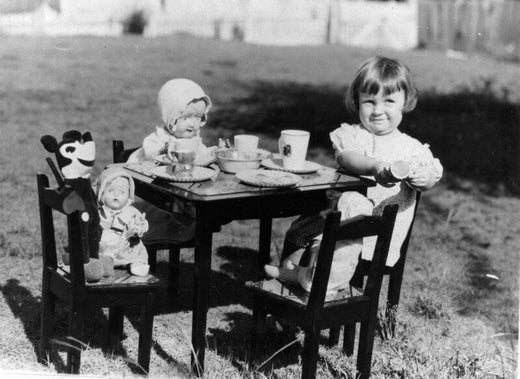Reversible dolls are much more than simple toys. Their design, featuring two characters in a single fabric doll, hides stories of resilience and cultural narratives. These pieces not only reflect creativity and craftsmanship, but also the social context of those who created and used them.
Over the years, I have gathered information about these dolls from books, articles, museums, and conversations with people who have shared their knowledge with me.
My intention is not to offer a formal historical analysis, but rather to share what I have learned through personal research and a genuine interest in discovering more about the history behind these handmade dolls, so very special.
🪆 Afro-American Reversible Dolls (USA, 19th Century)
The Topsy-Turvy dolls, as they are commonly known, have an uncertain origin, but most historical records place them on the plantations of the southern United States in the early 19th century. These dolls, made up of two figures joined at the waist—usually a white woman and a black woman—carry a deep and complex meaning that still sparks debate among historians and anthropologists today.
This is just a very brief summary, as the subject could easily fill an entire book. For those who wish to delve deeper, I recommend reading the following article:
👉 Flip Dolls: A Not-So-Brief History and a Challenge to Readers

Topsy-Turvy Doll, 1901. Fabric doll manufactured by Bruckner, showcasing two characters in one design. Image courtesy of North Dixie Designs. I highly recommend visiting their website.
Why Were These Dolls Created?
The reasons behind the creation of Topsy-Turvy dolls are not entirely clear, but several theories attempt to explain their origin:
-
A Reflection of Plantation Children's Reality:
White and black children played together, although their lives were marked by profound inequality. Having both representations in a single doll captured this duality. -
A Tool for Teaching Caretaking Skills:
Dorothy A. Mays, in her book Women in Early America, explains that enslaved girls were often paired with their owners' daughters to be both companions and servants. Playing with this antique fabric doll, which represented two distinct racial figures, may have reinforced social divisions, or perhaps, momentarily, helped the girls forget them. -
A Subversive Design:
Some believe that the design of these dolls was a silent way of questioning racial and social structures of their time, representing the tensions and realities of that era in a hidden manner.

Topsy-Turvy Doll. E.F. Lewis Doll Collection, Langston University. Explore more about this fascinating collection here.
More Than Toys
These dolls were not just toys, but also silent witnesses to an era marked by deep injustice and inequality. At times, they subtly defied the oppressive social structures of their time, offering a quiet yet powerful reflection of a dark chapter. Today, they remain an important material testimony of that complex era and of the stories woven around them.

Vintage photograph from the Deborah Neff Collection at the Fondation Antoine de Galbert. The image highlights the historical significance of Topsy-Turvy dolls in the 19th century.
👉 At the following link, you can find an incredible and extensive collection of dolls: Black Dolls: The Deborah Neff Collection
🪆 Little Red Riding Hood and the Big Bad Wolf Reversible Doll
One of the most well-known reversible dolls in Europe is the one that represents the story of Little Red Riding Hood and the Big Bad Wolf. These fabric dolls bring several characters from the tale to life, making storytelling much more fun and interactive.

For me, this type of doll is my favourite version, as it’s the one I had when I was little. I’ve created a modern version with a friendly wolf, which you can see here.
Over the years, I’ve met many older people who remember having one of these dolls in their childhood, or who, upon seeing one of mine, have awakened that memory. After many conversations, I’ve come to understand that these dolls are often family treasures, genuine nostalgic toys, that evoke the warmth of bygone times and were beloved vintage toys in the early 20th century.
🪆 Baiana Rica e Pobre Reversible Doll (Brazil)
A couple from Brazil once stopped to talk to me at a market and explained that there is a type of reversible doll there known as the "baiana rica e pobre". They couldn’t give me many details, only that these dolls showed a "wealthy baiana" on one side and, when flipped, revealed a "poor baiana" on the other.
Although I haven’t found specific sources detailing the exact symbolism of these dolls, their design seems to represent the socioeconomic differences present in Bahian society.

The image of the "baiana" is emblematic in Brazilian culture, especially in Bahia. These women are recognised for their traditional outfits, which include turbans, necklaces, and colourful dresses, each one laden with symbolism and reflecting the religious and cultural identity of the region.
If you're curious to learn more about the cultural significance of the baianas, I recommend these two articles:
I’ve done my best to cite sources and be as accurate as possible. This text is a tribute to the history behind these dolls, a reminder of their cultural richness, and an example of how traditional toys tell stories. Finding reliable sources isn’t always easy, and I don’t have the tools or the knowledge to fact-check every detail. However, the information I share here is what I’ve repeatedly come across over the years, so I trust it to be accurate. I’m not a historian, honestly, history was never my best subject at school (some things never change!). But I’ve approached this with genuine curiosity and a lot of care.
These dolls are not just objects from the past but also stories that deserve to be told and preserved. Thank you for reading. ❤️
If you’d like to know more, explore my own versions of these dolls, or simply chat about them, I invite you to visit my website or follow me on social media. I’d love to hear from you and continue sharing stories!

